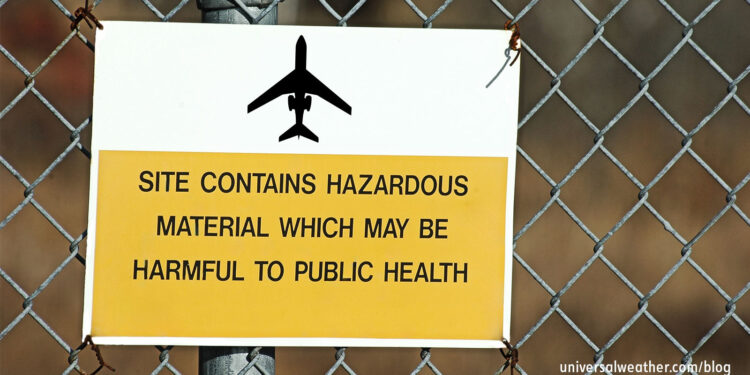Hazmat Flights: How-to for Business Aviation Operations

“Hazmat” is anything capable of posing significant risk to health/safety when transported. Hazmat materials may be biological, chemical, or physical. Having undeclared materials that are considered “hazmat” on board has potential to complicate an international flight operation – resulting in flight delays, substantial fines, and/or detention of aircraft and crew.
The following is an overview of what you need to know:
1. Examples of hazmat
Hazmat regulations cover common items – such as lithium batteries, flammable liquids, household solvents (e.g., drain cleaners), pressure containers including oxygen tanks, and dry ice – all the way up to fissile nuclear materials and radioactive isotopes. A common hazmat issue we’ve seen for general aviation is transport of human bodies. In such cases it’s always important to ensure the body is included in the manifest and that appropriate notification has been made to customs. Proper containment of a traveling body is usually a hazmat stipulation, and these requirements should always be checked and confirmed in advance. Weapons and ammunition are also common hazmat items, and each country has regulations on what is permitted and under what conditions.
2. Hazmat declaration requirements vary by country
Each country has its own regulations on hazmat and proper protocol/procedures for carriage. When in doubt it’s always best to check in advance, with your 3rd-party provider or ground handler, to ensure you will not have any issues when traveling to specified countries.
3. Hazmat permits – overflight and landing
Many countries require both overflight and landing permits for carriage of hazmat. When permits are required, it’s important to understand all relevant documentation mandates. In most cases minimum documentation includes proper and complete shipping documents along with written notification to the country to which these materials will be transported. Shipping documentation must be signed by either the captain or the shipping company. If there are changes to what was approved on a permit, a revision or application for a new permit is required. It’s important to determine how hazmat materials will be handled, packaged, and secured for transport and to ensure you’re operating within appropriate regulatory guidelines of the particular country.
4. Short-notice and diplomatic permits
Short-notice hazmat transport permits may be possible depending on the purpose of the flight and the countries concerned. For example when operators transport bodies, many countries may allow a shorter lead time for permits. In the case of diplomatic flights, with hazmat onboard (including transport of bodies or fissile materials), special approvals may be required via diplomatic channels, and your 3rd-party provider will not be able to assist with this.
5. Licensing for hazmat transport
Operators must be approved to transport dangerous goods by the Civil Aviation Authority (CAA) of their state or origin. There are different classifications of dangerous goods, and these determine how a material is handled, packaged, labeled, and transported. In the U.S. operators will not be licensed to carry hazmat as cargo until they’ve completed a Federal Aviation Administration-approved hazardous materials training program. This training typically addresses transport of explosives, gases, poisons, flammable liquids, radioactive materials, etc. In many cases operators must obtain permits from the destination country for hazmat transport. Permit lead time is typically 2-10 days, and this process requires full information and shipping documentation submitted in advance.
6. Top hazmat transport considerations
The first step is to determine if a particular hazmat item can be transported by air. The following are some questions to consider when looking at transporting hazmat material:
- Is your company properly licensed to transport dangerous goods, and is the crew appropriately trained to accept hazmat for transport and to secure and load/unload the material?
- Is the aircraft properly designed/configured to allow hazmat to be transported without risk to aircraft, passengers, or crew?
- Is the material safely packaged/contained with proper labeling, according to regulations for the particular hazmat classification?
- Do you have all required documentation describing the type of material to be transported – along with shipper’s contact information and protocol procedures – in the event of an emergency/accident?
- Has proper notification been submitted, and permission received, from the destination country?
7. Additional considerations and tips
Depending on the hazmat material in question, you may want to communicate with a customs broker to determine required permits, documentation, and procedures. Note that CAAs of many countries do not publish this type of information as they don’t deal with these sorts of flights frequently. Additional pre-trip research may be needed. Also, check with your governing authority on what permissions are needed to transport various categories of hazmat. Part 91 private non-revenue operators may want to consider implementation of a hazmat training program.
8. Links for more information
Information on transporting hazmat can be found at www.faa.gov, www.icao.int, and www.iata.org.
Conclusion
For hazmat transport always ensure you’ve provided full disclosure to appropriate authorities. Speak with your 3rd-party provider, and research particular hazmat requirements at destination locations. Always allow sufficient lead time for permits/revisions for any hazmat flight that requires special permits.
Questions?
If you have any questions about this article, contact me at greglinton@univ-wea.com.




